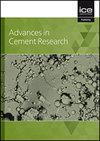废氧化镁粉部分替代水泥对自密实混凝土的影响
IF 1.3
4区 工程技术
Q3 CONSTRUCTION & BUILDING TECHNOLOGY
引用次数: 0
摘要
本试验研究了氧化镁(MgO)废料对自密实混凝土(SCC)性能的影响。在水胶比为0.40的系列中,在SCC中,氧化镁废物的重量分别为2%、4%和10%,取代了水泥。通过勒夏特列试验、坍落度流动、抗压强度、抗折强度、承压下水侵彻深度、超声脉冲速度和毛细管吸水率试验对样品性能进行评价。采用x射线衍射、热重分析、压汞孔隙分析、差热分析和扫描电镜对样品进行微观结构分析和物相定量。结果表明,镁渣混凝土中含有水化硅酸镁(M-S-H)和水镁石((Mg(OH) 2)产物。水石膏引起混凝土强度损失。在90天内,含镁试样的抗压和抗折强度均有所提高。随着废镁量的增加,孔隙率、压水渗透深度和毛管吸水率均增大。在SCC混合物中加入超过10%的氧化镁废料导致强度下降。氧化镁废液的加入促进了SCC的膨胀。氧化镁废的最佳投加量(2%)对SCC的强度最有利。本文章由计算机程序翻译,如有差异,请以英文原文为准。
Effects of waste magnesia powder as partial cement replacement on self-compacting concrete
This experimental study investigated the performance of self-compacting concrete (SCC) mixes with magnesia (MgO) waste. In the series produced with a water/binder ratio of 0.40, cement was replaced by magnesia waste at 2%, 4% and 10% by weight in the SCC. Le Chatelier test, slump flow, compressive strength, flexural strength, depth of penetration of water under pressure, ultrasonic pulse velocity and water absorption by capillary testing was conducted to assess sample performance. X-ray diffraction, thermogravimetric analysis, mercury intrusion porosimetry, differential thermal analysis and scanning electron microscopy were used for the microstructural analysis and quantification of phases within each sample. The results indicated that concrete with magnesia waste contains magnesium silicate hydrate (M–S–H) and brucite ((Mg(OH) 2 ) products. Brucite causes strength loss in concrete. Up to 90 days, specimens with magnesia showed increasing compressive and flexural strength. As the amount of magnesia waste increased, the porosity, depth of water penetration under pressure and water absorption by capillary increased. Incorporating more than 10% of magnesia waste in the SCC mixtures resulted in declining strength. The addition of magnesia waste enhanced the expansion of SCC. An optimum dosage (2%) of magnesia waste was the most advantageous to the strength of SCC.
求助全文
通过发布文献求助,成功后即可免费获取论文全文。
去求助
来源期刊

Advances in Cement Research
工程技术-材料科学:综合
CiteScore
3.70
自引率
5.00%
发文量
56
审稿时长
3.2 months
期刊介绍:
Advances in Cement Research highlights the scientific ideas and innovations within the cutting-edge cement manufacture industry. It is a global journal with a scope encompassing cement manufacture and materials, properties and durability of cementitious materials and systems, hydration, interaction of cement with other materials, analysis and testing, special cements and applications.
 求助内容:
求助内容: 应助结果提醒方式:
应助结果提醒方式:


